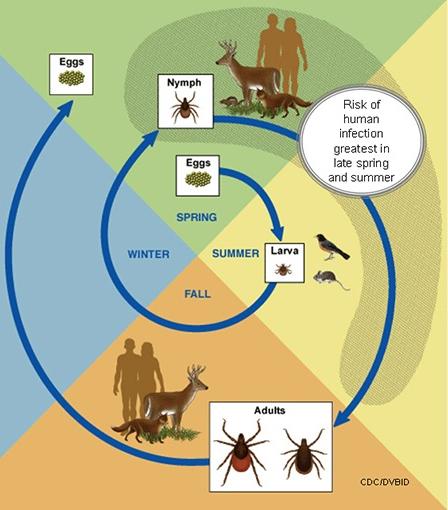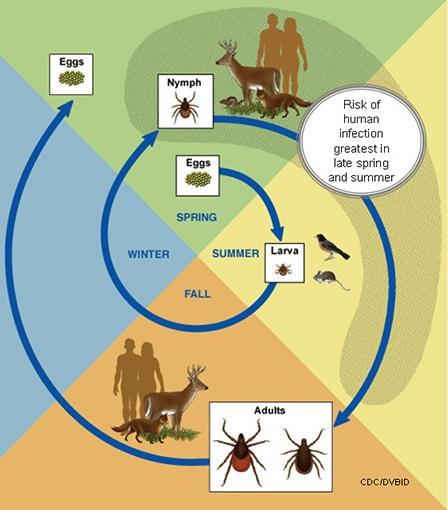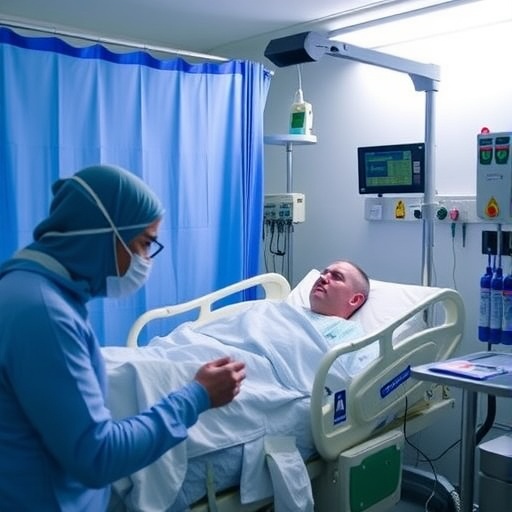
IMAGE: This is a picture of the lifecycle of Ixodes scapularis tick.
Credit: Credit: CDC
With tenacity befitting their subject, an international team of nearly 100 researchers toiled for a decade and overcame tough technical challenges to decipher the genome of the blacklegged tick (Ixodes scapularis).
The National Institute of Allergy and Infectious Diseases (NIAID), part of the National Institutes of Health, contributed primary support to the research, which appears in the online, open-access journal Nature Communications.
"Ticks spread more different kinds of infectious microbes to people and animals than any other arthropod group," said NIAID Director Anthony S. Fauci, M.D. "The spiral-shaped bacterium that causes Lyme disease is perhaps the best known microbe transmitted by ticks; however, ticks also transmit infectious agents that cause human babesiosis, anaplasmosis, tick-borne encephalitis and other diseases. The newly assembled genome provides insight into what makes ticks such effective disease vectors and may generate new ways to lessen their impact on human and animal health."
Catherine A. Hill, Ph.D., of Purdue University, headed the team of investigators. Aside from the logistical challenges of coordinating activities of dozens of workers across many time zones, the researchers' focus was a creature that is extremely difficult to maintain and that lives a long time — up to two years in the wild and nine months in the lab, Dr. Hill noted. Ixodes ticks have three blood-feeding life stages, and during each one, they feed on a different vertebrate animal. During feeding, ticks ingest blood for hours or days at a time. After mating, adult female ticks rapidly imbibe a large blood meal during which they expand hugely. "Because genes may switch on or off depending on the life stage of the tick, we needed to culture and collect ticks at each stage for analysis. This was not easy to do," said Dr. Hill.
Another challenge was the sheer size of the tick genome — some 2.1 billion DNA base pairs — and expansive regions where sequences are repeated. "The degree of DNA repetition–approximately 70 percent of the total — made assembling the full genome in the correct order very difficult," Dr. Hill said. In the end, the team determined the order and sequence of about two-thirds of the total genome. "We determined the sequence for 20,486 protein-coding genes," she said, "of which 20 percent may be unique to ticks. Those tick-specific genes are like guideposts that say 'start here' as we look for new ways to counter infectious ticks."
Although the latest research represents just a first look at the tick genome, the scientists have already identified genes and protein families that shed light on why Ixodes ticks succeed so well as parasites and hint at the reasons they excel at spreading pathogens, Dr. Hill noted. For example, compared with other blood-feeders, ticks have many more proteins devoted to consuming, concentrating and detoxifying their iron-containing food. Although mosquitoes — which quickly siphon up relatively small amounts of blood through a tube-like mouthpiece–have several proteins dedicated to blood digestion, ticks have many more proteins involved in this process. Other genes code for proteins that help ticks concentrate the blood and rapidly excrete excess water that accompanies large blood meals. Still other genes allow ticks to quickly expand their stiff outer coats to accommodate a 100-fold increase in total body size during blood feeding.
Other peculiarities of the tick's lifestyle reflected in the genome include genes associated with the multifaceted sensory systems that the parasite uses when "questing" for a host during each of its separate blood-feeding stages. Compared with mosquitoes, ticks appear to have fewer genes used to detect hosts, and, unlike a mosquito's "smell" receptors, ticks may use "taste" receptors to locate their food sources.
Each of the newly identified proteins is a potential target for new, tick-specific interventions, explained Dr. Hill. "The genome gives us a code book to the inner workings of ticks. With it, we can now begin to hack their system and write a counter-script against them."
In an effort to explain variations in Lyme disease prevalence across the United States, the team also examined genetic diversity within and among I. scapularis populations gathered from five states in the Northeast and Midwest and three in the South. Some have speculated that ticks in the Northeast and Midwest spread the bacteria that cause Lyme disease more easily than those in the South, or that the two populations perhaps comprise separate species. The genetic analysis showed that there is only one species of I. scapularis, said Dr. Hill, but subtle genetic differences were detected, and these may help explain some of the variance in the ability of populations to transmit disease and, therefore, affect disease prevalence.
Dr. Hill admits to a grudging admiration for her eight-legged subjects. "I find them almost endearing in the way they stick so firmly to the business of parasitizing their hosts. They are persistent and resilient. In a way, our team took a page from the tick's book in working together over so many years until we achieved our goal."
###
Other team members in the multi-disciplinary project included Bruce Birren, Ph.D., of the Broad Institute of MIT and Harvard in Cambridge, MA; Frank H. Collins, Ph.D., of the University of Notre Dame, Notre Dame, IN; Claire M. Fraser, Ph.D., of the Institute for Genome Sciences, University of Maryland School of Medicine in Baltimore; and Karen E. Nelson, Ph.D., of the J. Craig Venter Institute (JCVI) in Rockville, MD. The NIAID Genomic Centers for Infectious Diseases program supported the sequencing activities at the Broad Institute, JCVI and the University of Maryland.
NIAID scientist and co-author Jose M. Ribeiro, Ph.D., was supported through the NIAID intramural research program. Additional Department of Health and Human Services, NIH and NIAID grants and contracts used in support of this research: N01-AI30071, HHSN272200900007C, HHSN266200400001C, 5R01GM77117-5, HHSN266200400039C, HHSN272200900039C, NIH-1R01AI090062, NIH 1R21AI096268, TL1 TR000162, HHSN272200900040C, R01AI017828 and R01AI0430069C, HHSN272200900039C, NIH-1R01AI090062, NIH 1R21AI096268, TL1 TR000162, HHSN272200900040C, R01AI017828 and R01AI043006.
NIAID conducts and supports research — at NIH, throughout the United States, and worldwide — to study the causes of infectious and immune-mediated diseases, and to develop better means of preventing, diagnosing and treating these illnesses. News releases, fact sheets and other NIAID-related materials are available on the NIAID website.
About the National Institutes of Health (NIH): NIH, the nation's medical research agency, includes 27 Institutes and Centers and is a component of the U.S. Department of Health and Human Services. NIH is the primary federal agency conducting and supporting basic, clinical, and translational medical research, and is investigating the causes, treatments, and cures for both common and rare diseases. For more information about NIH and its programs, visit http://www.nih.gov.
NIH…Turning Discovery Into Health®
Reference: M Gulia-Nuss et al. Genomic insights into the Ixodes scapularis tick vector of Lyme disease. Nature Communications DOI: 10.1038/ncomms10507 (2016).
Media Contact
Anne A. Oplinger
[email protected]
301-402-1663
@NIAIDNews
http://www.niaid.nih.gov





